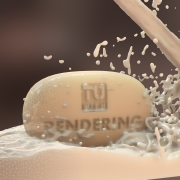The synthesis of photorealistic images has always been a major challenge in the field of computer graphics and is of great relevance for many applications such as motion picture production, computer games and architectural lighting simulations. Despite our detailed knowledge behind the physical processes of light transport, accurate and efficient simulation is still a challenge and subject to a vast amount of research work. This is due to the fact that light transport is extremely intricate: a single photon, emitted from a particular light source, can interact many times with various materials until it finally reaches the human eye.
Current state-of-the-art methods in the field of photorealistic rendering rely on Monte Carlo integration of the incident radiance. As opposed to traditional physical applications, where the solution emerges as the result of one Monte Carlo process, photorealistic rendering is, by principle, different: a separate Monte Carlo process is run for every pixel, resulting in visually unpleasant images. We show that in order to completely eliminate the noise, one either has to resort to rendering an enormous amount of samples per pixel (up to the order of hundreds of thousands) or use noise filtering, where we show that as of now, all methods have their inherent drawbacks.
However, our experiments and experience have led us to two key insights that will open up the road towards noise-free photorealistic rendering:
Our first key insight is that the most difficult light-transport phenomena usually exist on a low-dimensional manifold that can be specifically sampled exhaustively, resulting in images that are completely noise-free with respect to these difficult light-transport situations.
Our second key insight is that noise filtering is a viable way to mitigate noise for simple light transport effects, such as low-frequency illumination on diffuse surfaces.
Consequently, the goal of this project is to develop a fundamentally new method that it combines the approaches of (1) exhaustively sampling special path-space manifolds and (2) applying noise filtering to the remaining space. To this end, we will provide a mathematical model to quantify the effectiveness of modern noise-filtering methods.
More concretely, the project will make the following contributions to photorealistic rendering:
(1) An analysis and visualization of the space of light paths to build a better understanding how most state-of-the-art algorithms can be improved to perform better in challenging light-transport situations.
(2) A new class of algorithms that are capable of rendering the most difficult light-transport situations effectively in a fundamentally new way that guarantees that these phenomena always appear completely smooth and converged.
(3) A new way of combining noise-filtering techniques with photorealistic rendering algorithms, where each technique is used for the subclass of light paths where it is the most useful.
Funding
- FWF P27974
Research Areas
- In this area, we concentrate on algorithms that synthesize images to depict 3D models or scenes, often by simulating or approximating the physics of light.
Publications
4 Publications found:
Download list as Bibtex, HTML (Advanced, Expert), JSON (with referenced objects), CSV, Permalink
| Image | Bib Reference | Publication Type |
|---|---|---|
| 2020 | ||
 |
Karoly Zsolnai-Fehér , Peter Wonka , Peter Wonka , Michael Wimmer , Michael Wimmer Photorealistic Material Editing Through Direct Image Manipulation Computer Graphics Forum, 39(4):107-120, June 2020. [  paper] [Supplementary video] paper] [Supplementary video] |
Journal Paper with Conference Talk |
| 2019 | ||
 |
Karoly Zsolnai-Fehér Photorealistic Material Learning and Synthesis Supervisor: Michael Wimmer  Duration: 2013 — 2019 [  thesis] thesis] |
PhD-Thesis |
| 2018 | ||
 |
Karoly Zsolnai-Fehér , Peter Wonka , Peter Wonka , Michael Wimmer , Michael Wimmer Gaussian Material Synthesis ACM Transactions on Graphics (SIGGRAPH 2018), 37(4):76:1-76:14, August 2018. [  paper] [ paper] [ supplementary] [ supplementary] [ video] video] |
Journal Paper with Conference Talk |
| 2017 | ||
 |
Daniel Cornel, Hiroyuki Sakai , Christian Luksch, Michael Wimmer , Christian Luksch, Michael Wimmer Forced Random Sampling: fast generation of importance-guided blue-noise samples The Visual Computer, 33(6):833-843, June 2017. [ |
Journal Paper with Conference Talk |

